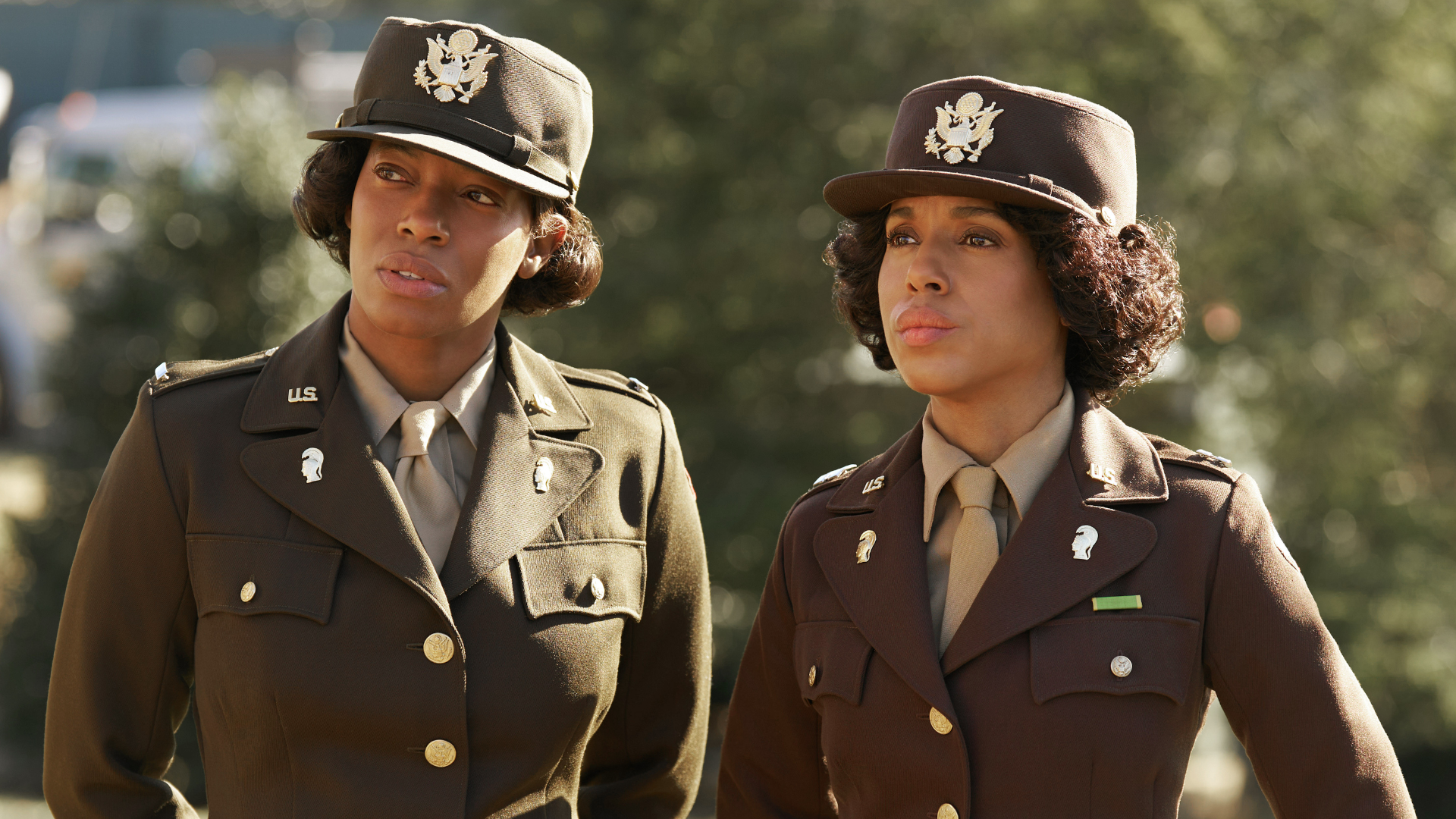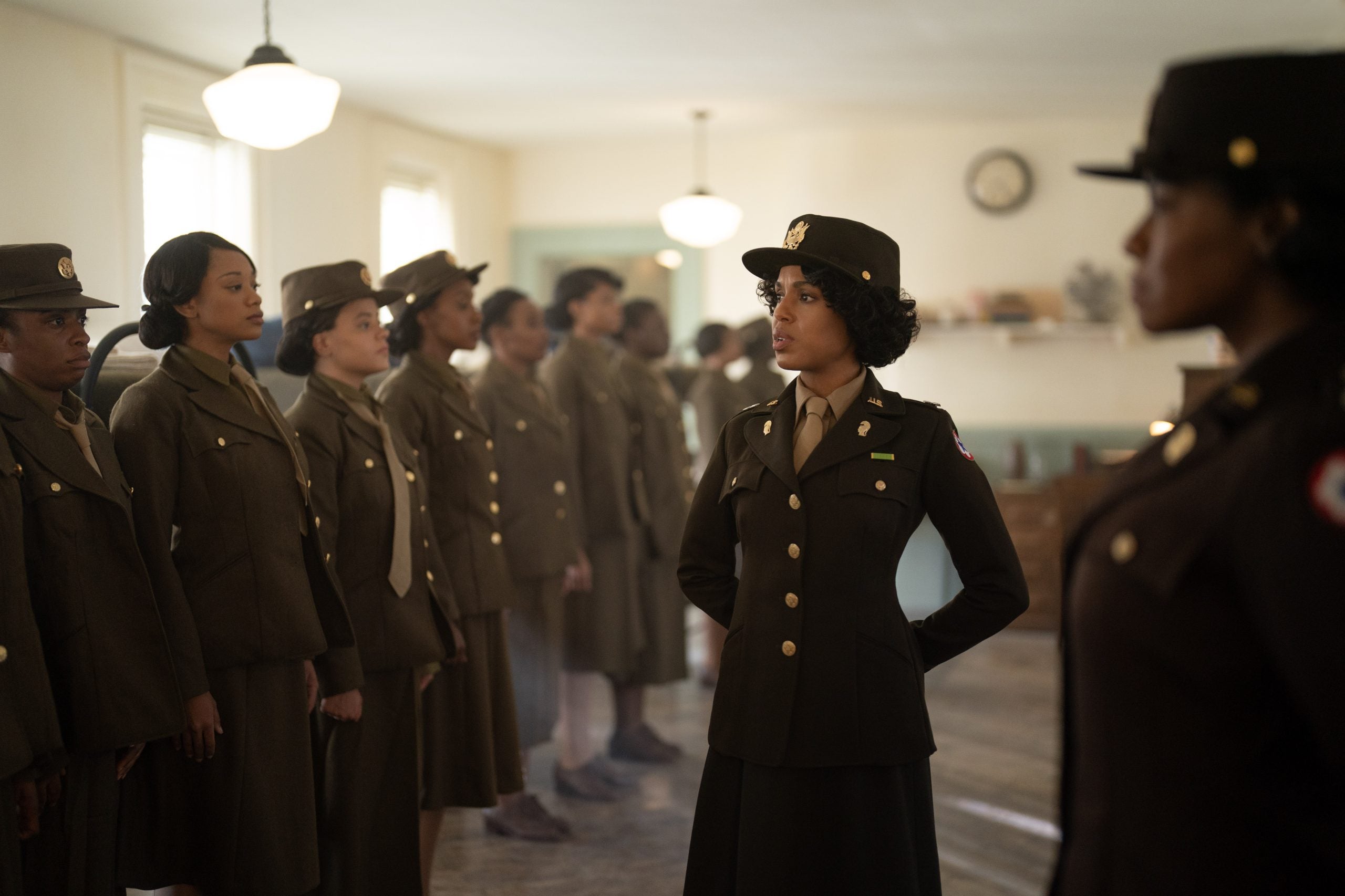
One particular scene in Netflix’s The Six Triple Eight directed by Tyler Perry was awe-inspiring. When the women who made up the Women’s Army Corp Unit that the film centers around during WWII were arriving in Glasgow. Their attire, matching, clean-cut coats and leather boots they wore painted them as a well-oiled machine that isn’t there to make a mockery of themselves. Rather they’ve arrived to dutifully serve and complete each of their tasks. Aside from this moment, there are many others in the film that are key to providing a look at the unsung heroes.
The costume design spearheaded by Karyn Wagner is spot-on when the 6,888th Central Postal Directory Battalion marched after arriving for their pivotal roles: to clear millions of letters and packages by soldiers. Notably, the 6,888th Battalion was the only unit of Black women deployed overseas during WWII. Over a video call, Wagner tells me that the jackets and uniforms they wore in the previously mentioned scene were costly. But, because she had a specific vision, and Perry believed she could execute it, she and her team utilized factories in multiple countries to create these uniforms.

“We took the old uniforms that we could find, and we sort of base the patterns on them, but then we changed them, also because African-American women tend to be curvier,” Wagner tells ESSENCE. She adds that she and her team also remade patterns from the newly debuted uniform that launched in 1944 for women who joined the United States Army.
As lead costume designer Wagner was able to shed a light on history-defining individuals who aren’t household names as they were stationed in Birmingham amid WWII. Her credits are filled with period films including the cult classic Eve’s Bayou, the beloved box office hit The Green Mile and also Underground, the acclaimed television series and Tyler Perry’s The Jazzman Blues. For The Six Triple Eight she was led by the autobiography by Major Charity Adams played by Kerry Washington. Adams, the first Black woman to receive the lieutenant colonel rank, was a stickler for a pristine uniform. So, her depicted character and unit always appeared dressed appropriately at all times. Their uniforms were never off-kilter with seams out of place, instead they were portrayed as nearly perfect.

Other pivotal moments within the film showcase the main characters pushing through moments filled with adversity served on a platter by grotesque figures. Racism and sexism ran rampant and would rear an ugly head on countless occasions throughout their journeys. However, their strength was seen not just on their faces–but it was also presented by Wagner by way of costuming. Lena Derriecott King (Ebony Obsidian), one woman who was given a backstory started on screen as a teenaged girl next door dressed in quaint mid-length pieces in a red, white and blue color palette marking her patriotic inclinations. As time went on she became a confident woman in uniform. Her style transformation was admirable and pivotal to the movie’s plot.
The Six Triple Eight delves deeply into class too. A scene that depicts this is when the titular characters are catching a train to attend specialized training in Georgia. In it, Derriecott King is presented as a middle-class woman in a blazer jacket in blue with red airplane buttons and a matching hat. Wagner says it was important for her jacket to come across as pristine.
Nearby Lena, another woman was depicted as a middle class Harlem native and a “Lindy Hopper” dancer took the train in a dress with dancers printed on it. Wagner explains that her outfit came into fruition after she saw a patterned swatch in the V&A Museum that she decided to recreate. “I wanted to present her as very sophisticated,” Lena shared.

Alternatively, Elaine White (Pepi Sonuga) a preacher’s daughter, is wearing what Wagner depicts as soft, a pale pink patterned dress with a grey buttoned jacket. “It makes a nod at being stylish because sea themes were very popular in the 1940s, but at the same time, the colors are non-confrontational.” To reflect the population of working class women who join the Army, Johnnie Mae played by Shanice Shantay appears in a worn looking jacket and frock. These items along with her flat shoes and unseamed Bobby socks were backdated to the 1920s to signal the difference in class.
Designing for The Six Triple Eight was a process that began in 2022 for Wagner. With the assistance of her team she created a period-centric culmination of what Black women were embracing on and off the base in Europe. Their well-tailored uniforms showcased their efforts to present themselves as rule-abiding and respectful women. Their clothing throughout the movie provided an opportunity to see a glimpse into how attire can also serve as a protective second skin. It also highlighted that clothing can be a protective mechanism amid the rampant adversity marginalized women often face in their lives.

Below we speak with Karyn Wagner on how she spearheaded the costume design in The Six Triple Eight, working with Tyler Perry, and how she executed the brilliant pieces worn by Kerry Washington, Ebony Obsidian, Oprah Winfrey, Milauna Jackson, and more.
ESSENCE: What was it like working with Tyler Perry for The Six Triple Eight?
Karyn Wagner: I think because we developed a good working relationship on The Jazzman’s Blues he trusts [me]. He trusts everyone to talk amongst themselves and figure out the best way of doing things. The thing about Tyler is that you very rarely get that kind of trust from directors or studios anymore as a department head. So when you do get it he invites you to do better than your best.
What was your logic going into designing for Ebony Obsidian who played Lena Derriecott King?
It’s a bit of a complex character. But she’s also a teenager in America in the ’40s. So I wanted to show the progression of her coming of age in high school. So I started with flat shoes and clothing that is geared more for a younger 16 than an older 16, and not as sophisticated, but an innocent young woman. And because she’s the most obviously patriotic of all these women. So I kept her themes to red, white, and blue. For the train scene, she’s also got a little heel on. So it’s just like this, she’s [saying]: “Now I’ve arrived. Now I’m becoming the woman I was always growing up to be.”

For the women in Lena’s life, her mother and aunt played by Donna Biscoe and Baadja-Lyne Odums, were you aiming to deliver any messages through their clothing?
The women who portrayed these two characters were a little bit older. It was clear that Lena is a late baby, not someone that [her mother] had in her 20s. They’re not wealthy. They’re putting everything they have into Lena. Every penny they can spare they’re putting [it] into Lena trying to save for college. So they’re not going to update their clothes, they’re not going to be modish. They’re not going to change up and wear ’40s styles just because it’s now the 1940s, they’re going to wear what’s still perfectly good.
There’s so many threads that get tied up in the aunt and the mother, and part of that is [to] make do and reuse. Part of that is funneling every penny they have into Lena. And part of it is just that these dresses are still perfectly serviceable. [Since] it wasn’t a fast fashion world, they probably made their clothes. So were they going to make new clothes that were fashionable or were they going to put their energy into being caterers? There was a lot of multi-layered decision-making there. But at the same time, I used brighter colors and happier prints for them because I didn’t want them to look depressed or sad, I didn’t want to portray any of that. I wanted them to represent women who maybe hadn’t had everything go their way in their life but were generally optimistic and happy to be here.
I was obsessed with Kerry Washington’s depiction of Major Charity Adams. What were you hoping would come across in her costume design?
Having read her book, I felt that Charity Adams had a great deal of self-pride. She [majored] in hard subjects I wouldn’t have [had] the patience to pass. Mathematics, Latin and [physics]. She was a force of nature in that she was so self-assured in her power that I think that even when things got horrible in the Army, I feel like that carried her through.
Charity [expressed] in her book how much she loved her tailors. She did love to buy herself a new uniform. And you see in the very last scene, you see her wearing these sort of canary yellow gloves. It was the one thing that she allowed herself that was not Army issue or Army protocol.

Oprah Winfrey depicted Mary McLeod Bethune in the film. Can you walk me through your process of executing this key look?
I must have had a hundred images of her. And what came through was a woman who nodded to fashion. [She was a] strong, amazing woman. She loved lace collars and she loved hats. I wanted to build something that said, “I can afford really nice things. I choose to keep what works and not change for fashion’s sake.” The other thing I did was the lace on her collar is from the 1890s. I wanted to mix some traditions, some history, and some current day shapes from the ’40s [to] make Oprah look as best as I can.
What were you aiming to showcase through the costuming of General Halt played by Dean Norris?
What I wanted to represent with [him and his colleagues] was a society that was not questioning [the] change that needed to come. So this very status quo of men who had probably been pushed higher up in rank by who they knew. Whereas Charity, one of the things that I remember very clearly wanting to show was that Charity climbed her way up using every possible thing in her arsenal, and these guys just sauntered in and they were like, “Joe, give me a cup of coffee and a donut,” and their day was done.







I feel like that was all helped and represented by the fact that the actor who played Halt is a bit corpulent, right? So here’s a guy who doesn’t take care of himself, doesn’t take care of his body, doesn’t feel he needs to, feels like he was born God. And then you see Charity come in and she’s trim and every uniform is tailored to perfection, and she thinks about every detail every moment of the day.

In The Six Triple Eight when the ladies were stationed and had some leisure moments, were you hoping to lean into depicting a level of comfortability? Or were you hoping to depict them as women who had to be on guard at all times.
It’s kind of a combination of both. Because they were in Great Britain and they were past the Blitz, which is where the Germans tried to bomb the U.K. into submission, that was earlier in the war. You have these women who are young and they’re used to having some playtime in real life, and they want to have a good time. They’re here to do something and they’re patriotic and a lot of them are there for really patriotic reasons, but then at the same time, there are tons of pictures of them playing baseball and visiting their British neighbors and having tea at people’s houses. So, it’s a combination of always being aware and always being ready.






